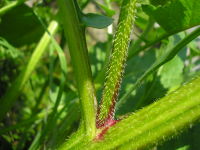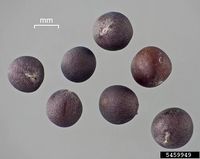Sinapis arvensis (weed)
| Literature database |
|---|
| 210 articles sorted by: |
| • year (descending) |
| • research topics |
| • countries/regions |
| • affected crops |
Author(s): Olivier Pichard
Source: Wikimedia Commons
Sinapis arvensis L. - (wild mustard)
The species is an important cruciferous weed native to the Old World which now has a world-wide distribution. It is particularly common in temperate regions and can be a problem in cereals and various other crops. Yields may be reduced by 50% at high weed densities (e.g. 20 plants per m2). In addition, it is a host of various fungal diseases and insect pests of crops. On the other hand, S. arvensis can be an important source of honey and pollen for bees.
A plant can produce up to 20,000 seeds per year. These disperse through the wind or by agricultural activities and remain viable for up to 10 years. The weed can build up a very persistent seed bank, but the seeds only germinate close to the surface. For control, herbicides or mowing are effective. However, herbicide resistance has been reported in several populations.
| Vernacular names | |
|---|---|
| • Deutsch: | Acker-Senf |
| • English: | wild mustard charlock |
| • Español: | mostaza de los campos |
| • Français: | moutarde des champs |
The plant grows to a height of 20-60 cm. The upper leaves are broadly triangular, short without petioles. The lower leaves have petioles, are lobed and up to 20 cm long. The flowers are bright yellow with 4 petals. The pods are 3-5 cm long, hairless with a long pointed tip. They contain around 10 black, spherical seeds, 1-1½ mm in diameter with a fine surface texture. Cotyledons are kidney-shaped.
Synonyms:
Brassica kaber
For a review see Warwick et al., 2000.
- Other images of Sinapis arvensis (weed) (Wikimedia Commons, IPM Images and Open Media - click to enlarge)







